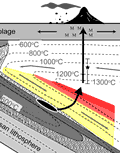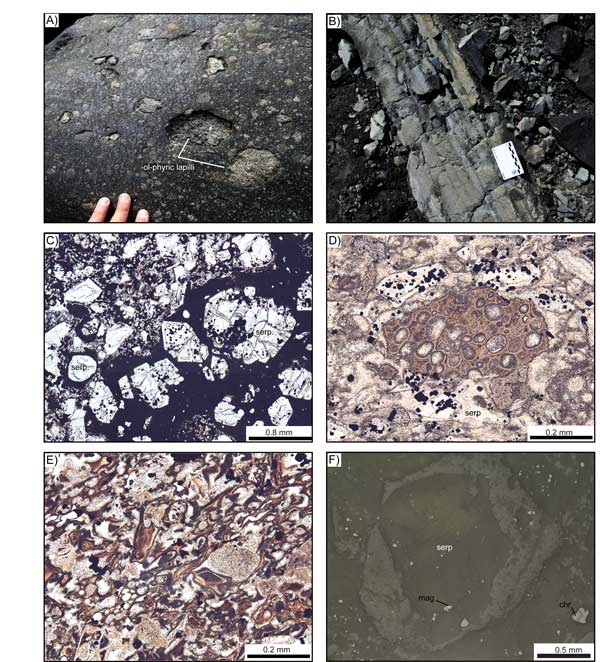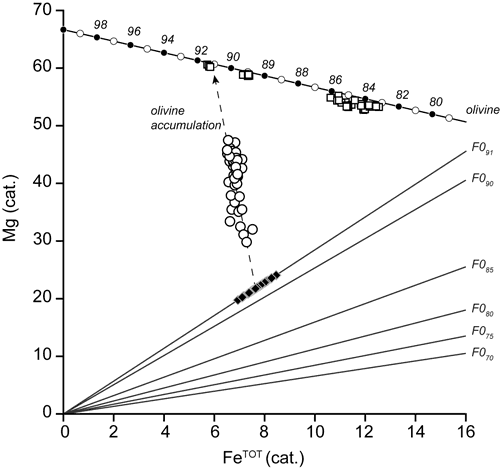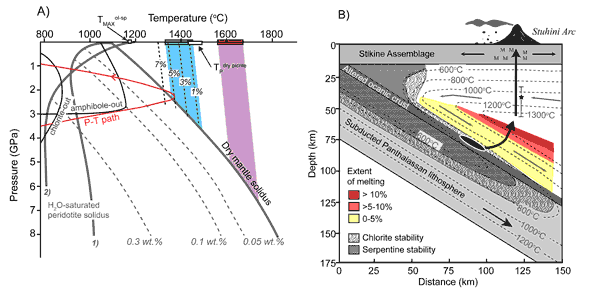 |
Water-driven generation of picritic melts in the Middle to Late Triassic Stuhini arc, Stikine terrane, British Columbia, Canada |
Dejan Milidragovic1,2, John B. Chapman2, Sebastian Bichlmaier3, Dante Canil3, Alex Zagorevski4
1British Columbia Geological Survey, 5th floor, 1810 Blanshard St., Victoria, BC, V8T 4J1; dejan.milidragovic604@gmail.com
2Geological Survey of Canada, 1500-605 Robson Street, Vancouver, BC, V6B 5J3, Canada; john.chapman@canada.ca
3School of Earth and Ocean Sciences, University of Victoria, 3800 Finnerty Road, Victoria, BC, V8P 5C2, Canada; sbichlmaier@gmail.com ; dcanil@uvic.ca
4Geological Survey of Canada, 601 Booth Street, Ottawa, ON, K1A 0E8, Canada; alex.zagorevski@canada.ca
This webpage is a summary of: Milidragovic, Dejan, John B. Chapman, Sebastian Bichlmaier, Dante Canil, Alex Zagorevski, H2O-driven generation of picritic melts in the Middle to Late Triassic Stuhini arc of the Stikine terrane, British Columbia, Canada, 65-77.
Introduction
The positive dependence between MgO concentration in primary basaltic liquids and temperature and depth of the peridotite source (e.g., Roeder & Emslie, 1970; Hanson & Langmuir, 1978) is a key concept in mantle petrology studies (Putirka et al., 2007; 2011; Herzberg & Asimow, 2015). It also has widespread application in the studies of tectonics and secular evolution of the Earth’s thermal state, and planetary petrology (Herzberg et al., 2010; Putirka, 2016). Studies of ultramafic magmas (MgO >12 wt.%) of Phanerozoic age are largely limited to those emplaced in intraplate settings (e.g., Baffin Island, Hawaii), and interpreted as reflecting the anomalously high temperature of their mantle sources. The general paucity of ultramafic magmas in interplate (MORB) and subduction settings is widely interpreted to reflect the ambient, relatively cool mantle temperatures during the Phanerozoic (Davies, 2009; Herzberg et al., 2010). This webpage examines the role of water, whose presence is implicit in mantle wedge melting (Grove et al., 2012), in the generation of ultramafic magmas in the Middle to Late Triassic Stuhini arc of the North American Cordillera.
Triassic arc picrites in northern Stikinia
Ultramafic (MgO = 21–33 wt.%) tuff breccia, lapilli tuff, and ash tuff of the Middle to Upper Triassic Stuhini Group were erupted in the Stikine Terrane of the North American Cordillera shortly preceding an episode of prolific porphyry Cu–Mo(–Au) mineralization. The ultramafic rocks have undergone greenschist facies metamorphism and are pervasively serpentinized. However, primary textures, including euhedral serpentine pseudomorphs after olivine, frothy lapilli, and cuspate bubble-wall glass shards, indicate explosive eruption driven by exsolution of primary, magmatic volatiles (Figure 1). Chromite is the sole mineral phase that withstood metamorphism and alteration.

Figure 1: A) Lapilli tuff - large, lighter coloured lapilli (2-7 cm across) containing subhedral olivine (black grains) are set in a fine-grained, dark green matrix. B) Thin rhythmic layering in ash tuff. C) Serpentinized, euhedral olivine phenocrysts (serp) in a devitrified matrix of a ~2 cm lapillus. D) Plane-polarized light image of a vesicular, devitrified scoria lapillus among fragments of serpentinized olivine. E) Plane-polarized light photomicrograph of concavo-convex, bubble-wall shards of clear to light- to dark brown brown, partially palagonitized, glass in an ash tuff bed. F) Reflected-light image of a subhedral, serpentinized olivine phenocryst hosted in devitrified fine grained groundmass. The serpentinized olivine phenocryst contains inclusions of euhedral chromite (chr; darker grey reflective mineral) mantled by thin rims of magnetite (mag; light grey reflective mineral).
The ultramafic tuff of the Stuhini Group shows accumulation (20–65%) of olivine (Fo91) and minor chromite into a near-primary, subalkaline picritic parental magma with MgO ~16 wt. (Figure 2). The calculated parental magma requires moderate degrees of melting (F =0.10-0.15; Putirka, 2016) of mantle peridotite at an average pressure of 1.2 GPa (Putirka 2008; Lee et al., 2009). Assuming equilibrium with Fo91, chromite phenocrysts record liquidus temperatures < 1200°C (Ballhaus et al., 1991) at oxygen fugacities one to three log units above the fayalite–magnetite–quartz (FMQ) buffer. The calculated chromite-olivine equilibration temperatures are > 200°C lower than the temperatures of comparably-magnesian anhydrous liquids (Ulmer, 2001). Together with textural observations this suggests that water played an important role in generation and emplacement of the Stuhini Group picrites.

Figure 2: Mg vs. FeTOT in cation units. The ultramafic rocks of the Stuhini Group (white circles) define an olivine control line, which intersects the stoichiometric olivine line at ∼Fo91. Lines radiating from the origin are isopleths of olivine composition coexisting with liquids whose Fe and Mg contents are specified by graph coordinates. The isopleths were calculated assuming KD =0.32 (e.g., Putirka et al., 2011), and Fe3+/FeTOT = 0.12. Squares: olivine compositions determined by WDS; Black diamonds: parental liquids, in equilibrium with Fo91, calculated by subtraction of olivine from each sample.
The average H2O concentration in primary arc magmas is ~3.5 wt.%, although higher concentrations (>6 wt.%) have been measured from individual volcanoes globally (Vigouroux et al., 2008; Plank et al., 2013). The mantle potential temperature (TP) of a primary Stuhini Group picritic magma containing 5–7 wt.% H2O, calculated using the olivine-liquid thermometer of Putirka et al. (2007) and the calibration of Putirka (2016), is 1300-1350°C (Figure 3A). The calculated TP highlights two points of fundamental importance to mantle petrology:
-
the calculated TP is equal to or lower than the TP of ambient mantle (1330-1450°C) demonstrating that high MgO magmas in equilibrium with Fo-rich olivine can be generated by melting of ambient-temperature mantle, and
-
in accordance with the thermal models for subduction zones (Grove et al., 2009), the calculated TP alleviates the need for catastrophic thermal perturbations in the mantle wedge as commonly implied for picrite magmas in island arc settings (Nye & Reid, 1986; Rohrbach et al., 2005; Logan & Mihalynuk, 2014).
Stated differently, if a plentiful water supply is available, any mantle wedge with a sufficiently hot nose will yield hydrous picritic melts. The bulk H2O concentration inferred for the mantle source of the Stuhini Group picrites is 0.7-0.9 wt.%. Similar H2O concentrations were invoked by Kelley et al. (2010) and Plank et al. (2013) for the mantle source of the Mariana arc lavas (0.6–1.0 wt.%).
A wet origin for arc picrites
The wet-melting origin for the Stuhini Group picrites requires efficient release of water through slab dehydration, followed by melting across the inverse geothermal gradient of the lower portion of the mantle wedge (Figure 3). The optimum scenario for genesis of hydrous arc picrites is in intermediate-temperature settings such as the southern Marianas subduction zone where upper crust undergoes near-complete dehydration in the 2.5-3 GPa (80-100 km) interval (van Keken et al., 2011). Breakdown of hydrous minerals in the subducting slab at temperatures exceeding the H2O-saturated peridotite solidus results in immediate melt production, ascent, and further hydrous flux melting into the “hot” nose of the mantle wedge where hydrous picritic melts are generated by moderate degrees of melting (0.10-0.15) at temperatures ≥1300°C.

Figure 3: A) P (GPa) vs. T (°C) diagram showing the dry mantle solidus (Katz et al., 2003), and water saturated solidi from 1) Katz et al. (2003) and 2) Grove et al. (2009). Chlorite (Grove et al., 2009) and pargasite (Green et al., 2014) stability fields (thin solid black lines), and peridotite solidii (grey dashed lines) for bulk water contents of 0.05, 0.1, and 0.3 wt.% are also shown. The white rectangle along abscissa (TPdry picrite) is the potential temperature of picrite parental magmas calculated assuming a dry composition and P using the equations of Putirka (2008) and Putirka (2016). The black dashed lines show the reduction in potential temperature at the given H2O concentration in the magma. The white square along abscissa (T ol-spMAX) is the maximum calculated olivine-spinel equilibration temperature. The blue and pink fields correspond to the potential temperatures of MORB (ambient mantle), and Hawaiian mantle sources. The solid red path illustrates a hypothetical path that a melt generated at P ≥ 3 GPa may take through the mantle wedge and overlying lithosphere. The dashed red line is a path, which remains in thermal equilibrium with its surroundings as it crosses the normal geothermal gradient of the uppermost arc mantle and lithosphere. B) A schematic section through a subduction zone (modified from Grove et al., 2009) showing the salient features of our model. Dehydration of subducting slab at 2.5–3 GPa (black ellipse; van Keken et al., 2011) leads to overstepping of the water-saturated solidus and hydrous flux melting up the geothermal gradient. Because of the coupling of the subducting slab and the overlying mantle (thin grey arrows), the melting column (thick black arrow) is not necessarily vertical. In the hot nose of the wedge, where T >1300°C, melting may exceed 10% (F >0.1) and water-rich picritic melts are generated. The estimated pressure of equilibration (1.2 +0.5/−03 GPa; star with error bars) reflects the depth at which melts last equilibrated. The ascent across the upper part of mantle wedge and through Stikinia’s lithosphere is adiabatic and driven by high buoyancy of the hydrous picritic magma (illustrated by the vertical ascent path) and lithospheric extension (horizontal black arrows). Hot water-rich melts may be an efficient transport agent of base and precious metals from the mantle into the crust of Stikinia (schematically shown by “M”). Click here or on Figure for enlargement.
All arc magmas must traverse the uppermost arc mantle and lithosphere and have a normal geothermal gradient (Figure 3B). The primitive chemistry of the Stuhini Group picrites requires a near-adiabatic path in which conductive thermal exchange with the upper mantle wedge and lower crust is minimal, allowing the ascending magma to preserve its primary composition. The volatile-rich nature of the melt and the predominant extensional regime in the overlying lithosphere of Stikinia facilitated the near-adiabatic ascent of the Stuhini Group picrites. Explosive ascent of the rapidly-devolatilizing, picrite magma above vapour-saturation pressure (0.3–0.5 GPa; Plank et al., 2013) is necessary to minimize water loss and fractional crystallization and removal of olivine. The high H2O content of the rapidly ascending picrite melt may have played a key role in transport of metals into the crust of the Stikinia and subsequent porphyry Cu–Mo(–Au) mineralization.
References
-
Ballhaus, C., Berry, R.G., and Green, D.H. (1991), High pressure experimental calibration of the olivine-orthopyroxene-spinel oxygen geobarometer: implications for the oxidation state of the upper mantle, Contrib. Mineral. Petrol., 107, 27–40.
-
Davies, G.F. (2009), Effect of plate bending on the Urey ratio and the thermal evolution of the mantle, Earth Planet. Sci. Lett., 287, 513–518.
-
Green, D.H., Hibberson, W.O., Rosenthal, A., Kovács, I., Yaxley, G.M., Falloon, T.J., and Brink, F. (2014) Experimental study of the influence of water on melting and phase assemblages in the upper mantle, J. Petrol., 55, 2067–2096.
-
Grove, T.L., Till, C.B., Chatterjee, N., and Medard, E. (2009), Kinematic variables and water transport control the formation and location of arc volcanoes, Nature, 459, 694–697.
-
Grove, T.L., Till, C.B., and Krawczynski, M.J. (2012) The role of H2O in subduction zone magmatism, Annu. Rev. Earth Planet. Sci., 40, 413-439.
-
Hanson, G.N. and Langmuir, C.H. (1978), Modelling of major elements in mantle- melt systems using trace element approaches, Geochim. Cosmochim. Acta, 42, 725–741.
-
Hezberg, C. and Asimow, P.D. (2015), PRIMELT3 MEGA.XLSM software for primary magma calculation: Peridotite primary magma MgO contents from the liquidus to the solidus, Geochim. Geophys. Geosyst.,16, doi:10.1002/2014GC005631.
-
Herzberg, C., Condie, K., and Korenaga, J. (2010) Thermal history of the Earth and its petrological expression, Earth Planet. Sci. Lett., 292, 79–88.
-
Katz, R.F., Spiegelman, M., and Langmuir, C.H. (2003), A new parametrization of hydrous mantle melting, Geochem. Geophys. Geosyst., 4, http://dx.doi.org/10.1029/ 2002GC000433.
-
Kelley, K.A., Plank, T., Newman, S., Stolper, E.M., Grove, T.L., Parman, S., and Hauri, E.H. (2010) Mantle melting as a function of water beneath the Mariana arc, J. Petrol., 51, 1711–1738.
-
Lee, C.-T.A., Luffi, P., Plank, T., Dalton, H., and Leeman, W.P. (2009), Constraints on the depths and temperatures of basaltic magma generation on Earth and other terrestrial planets using new thermobarometers for mafic magmas, Earth Planet. Sci. Lett., 279, 20–33.
-
Logan, J.M. and Mihalynuk, M.G. (2014), Tectonic controls on early Mesozoic paired alkaline porphyry deposit belts (Cu–Au ± Ag–Pt–Pd–Mo) within the Canadian Cordillera, Econ. Geol., 109, 827–858.
-
-
Nye, C.J. and Reid, M. (1986), Geochemistry of primary and least fractionated lavas from Okmok volcano, central Aleutians: implications for arc magma genesis, J. Geophys. Res., 91, 10271–10287.
-
Plank, T., Kelley, K.A., Zimmer, M., Hauri, E.H., and Wallace, P.J. (2013), Why do mafic arc magmas contain ∼4 wt.% water on average?, Earth Planet. Sci. Lett., 364, 168–179.
-
Putirka, K.D. (2008), Thermometers and barometers for volcanic systems, Rev. Mineral. Geochem., 69, 61–120.
-
Putirka, K.D. (2016), Rates and styles of planetary cooling on Earth, Moon, Mars, and Vesta, using new models for oxygen fugacity, ferric-ferrous ratios, olivine-liquid Fe–Mg exchange, and mantle potential temperature, Am. Mineral., 101, 819–840.
-
Putirka, K.D., Perfit, M., Ryerson, F.J., and Jackson, M.G. (2007), Ambient and excess mantle temperatures, olivine thermometry, and active vs. passive upwelling, Chem. Geol., 241, 177-206.
-
Putirka, K.D., Ryerson, F.J., Perfit, M., and Ridley, W.I. (2011), Mineralogy and composition of the oceanic mantle, J. Petrol., 52, 279–313.
-
Roeder, P.L. and Emslie, R.F. (1979), Olivine-liquid equilibrium, Contrib. Mineral. Petrol., 29, 275–289.
-
Rohrbach, A., Schuth, S., Ballhaus, C., Münker, C., Matveev, S., and Qopoto, C. (2005) Petrological constraints on the origin of arc picrites, New Georgia Group, Solomon Islands, Contrib. Mineral. Petrol., 149, 685–698.
-
Ulmer, P. (2001), Partial melting in the mantle wedge—the role of H2O in the genesis of mantle-derived ‘arc-related’ magmas, Phys. Earth Planet. Inter., 127, 215–232.
-
Van Keken, P.E., Hacker, B.R., Syracuse, E.M., and Abers, G.A. (2011), Subduction factory: 4. Depth-dependent flux of H2O from subducting slabs worldwide, J. Geophys. Res., 116, B01401. http://dx.doi.org/10.1029/2010JB007922.
-
Vigouroux, N., Wallace, P.J., and Kent, A.J.R. (2008), Volatiles in high-K magmas from the western trans-Mexican volcanic belt: evidence for fluid fluxing and extreme enrichment of the mantle wedge by subduction processes, J. Petrol., 49, 1589–1618.
last updated 20th
January, 2017 |
